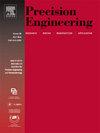Investigation on machinability and sustainability aspects during hard turning under GO nanofluid MQL environment for precision and cleaner manufacturing
IF 3.5
2区 工程技术
Q2 ENGINEERING, MANUFACTURING
Precision Engineering-Journal of the International Societies for Precision Engineering and Nanotechnology
Pub Date : 2025-05-13
DOI:10.1016/j.precisioneng.2025.05.006
引用次数: 0
Abstract
The current study involves the analysis of machinability and sustainability metrics during hard turning through Taguchi L27 OA design of experiment under GO nano-cutting fluid MQL environment by low cost CVD coated carbide tools. This study examines machinability and sustainability factors, including flank wear, surface integrity, cutting temperature, power consumption, carbon emissions, and noise emissions, during hard machining operations. GO nano-cutting fluid provides superior cooling and lubrication facility at the cutting zone, resulting in lowest cutting temperatures of 55.2 °C and cutting noise levels of 69.3 dB throughout the investigation. At a parametric combination of d (0.1 mm), f (0.05 mm), and v (200 m/min), the lowest surface roughness was detected, exhibiting minimal surface defects with high precision as the lowest circularity and cylindricity error obtained at this run. Feed (57.30 %) and depth of cut (49.51 %) significantly affect carbon emissions and noise emissions, respectively. Cutting speed is the primary factor influencing flank wear and temperature, with a contribution rate of 61.69 % and 47.50 %, respectively. Feed greatly influences surface roughness with a contribution rate of 44.95 %, whereas depth of cut predominantly affects cutting power with a contribution rate of 51.92 %. The multi-response optimization implementing WASPAS, followed by the entropy method, yields an optimal parametric combination of d (0.1 mm), f (0.05 mm), and v (80 m/min) within the examined range for the most favorable solution considering both machinability and sustainability.
面向精密清洁制造的氧化石墨烯纳米流体MQL环境下硬车削可加工性和可持续性研究
本研究通过低成本CVD涂层硬质合金刀具在氧化石墨烯纳米切削液MQL环境下的实验设计,分析了硬车削过程中的可切削性和可持续性指标。本研究考察了硬加工过程中的可加工性和可持续性因素,包括侧面磨损、表面完整性、切削温度、功耗、碳排放和噪音排放。氧化石墨烯纳米切削液在切削区提供了卓越的冷却和润滑设施,在整个研究过程中,最低切削温度为55.2°C,切削噪音水平为69.3 dB。在d (0.1 mm), f (0.05 mm)和v (200 m/min)的参数组合下,检测到的表面粗糙度最低,表面缺陷最小,精度高,是该运行获得的最小圆度和圆柱度误差。进给量(57.30%)和切削深度(49.51%)分别显著影响碳排放和噪声排放。切削速度是影响齿面磨损和温度的主要因素,贡献率分别为61.69%和47.50%。进给量对表面粗糙度的影响最大,其贡献率为44.95%,而切削深度对切削功率的影响最大,其贡献率为51.92%。采用WASPAS进行多响应优化,然后采用熵值法,在考虑可加工性和可持续性的情况下,在检测范围内得到d (0.1 mm)、f (0.05 mm)和v (80 m/min)的最优参数组合。
本文章由计算机程序翻译,如有差异,请以英文原文为准。
求助全文
约1分钟内获得全文
求助全文
来源期刊
CiteScore
7.40
自引率
5.60%
发文量
177
审稿时长
46 days
期刊介绍:
Precision Engineering - Journal of the International Societies for Precision Engineering and Nanotechnology is devoted to the multidisciplinary study and practice of high accuracy engineering, metrology, and manufacturing. The journal takes an integrated approach to all subjects related to research, design, manufacture, performance validation, and application of high precision machines, instruments, and components, including fundamental and applied research and development in manufacturing processes, fabrication technology, and advanced measurement science. The scope includes precision-engineered systems and supporting metrology over the full range of length scales, from atom-based nanotechnology and advanced lithographic technology to large-scale systems, including optical and radio telescopes and macrometrology.

 求助内容:
求助内容: 应助结果提醒方式:
应助结果提醒方式:


